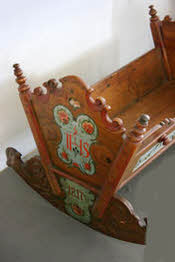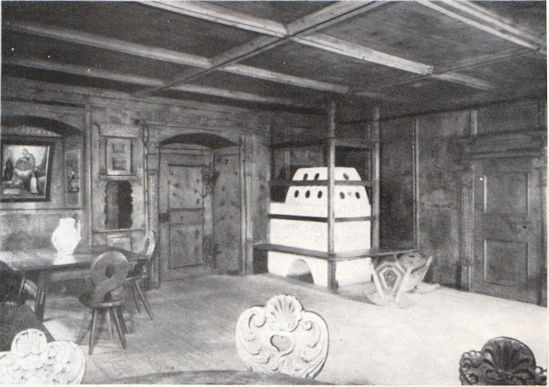Plinio Corrêa de Oliveira
Two rooms.
 The first belongs to a building with thick walls, easily seen by the deep encasement of the two windows that allow the light to enter through their thick panes yet protect the room from the cold. The wide borders of carved wood and the finely sculpted ceiling beams finish the room, which gives one an impression of the comfort, solidity and good taste proper to the warmth of a domestic intimacy that is unpretentious although very dignified. The sturdy buy attractive furniture accentuates this note.
The first belongs to a building with thick walls, easily seen by the deep encasement of the two windows that allow the light to enter through their thick panes yet protect the room from the cold. The wide borders of carved wood and the finely sculpted ceiling beams finish the room, which gives one an impression of the comfort, solidity and good taste proper to the warmth of a domestic intimacy that is unpretentious although very dignified. The sturdy buy attractive furniture accentuates this note.
An identical atmosphere can be perceived in the second room, whose ambience is distinguished by a large hearth and a religious picture. The small wooden cradle and the three elegantly carved chairs in the foreground are veritable works of art.
 These two rooms are from homes in the Tyrol. The mere mention of this region is sufficient for the reader to conjure up images of a snowy resort inn frequented by wealthy tourists. What a mistake! These are photographs of the carved wooden revetments and furniture of sixteenth-and-seventeenth-century Austrian peasant homes preserved in the Museum of Popular Tyrolean Art, in Innsbruck, Austria.
These two rooms are from homes in the Tyrol. The mere mention of this region is sufficient for the reader to conjure up images of a snowy resort inn frequented by wealthy tourists. What a mistake! These are photographs of the carved wooden revetments and furniture of sixteenth-and-seventeenth-century Austrian peasant homes preserved in the Museum of Popular Tyrolean Art, in Innsbruck, Austria.
 When compared to the benefits these ambiences afford to the spiritual life of the peasant as well as to his physical health and comfort, how distant seem the pretentious and cold slum-like dwellings of cement hurriedly built here and there by those who, disdainful of any tradition, pride themselves on being super modern. To see such structures, all one has to do is walk through the outskirts of a modern metropolis. Upon approaching these edifices, the passerby is almost too scared to cross their thresholds.
When compared to the benefits these ambiences afford to the spiritual life of the peasant as well as to his physical health and comfort, how distant seem the pretentious and cold slum-like dwellings of cement hurriedly built here and there by those who, disdainful of any tradition, pride themselves on being super modern. To see such structures, all one has to do is walk through the outskirts of a modern metropolis. Upon approaching these edifices, the passerby is almost too scared to cross their thresholds.
This comparison shows how it would be wrong to imagine that in the centuries of Christian civilization zeal was lacking for the welfare of the common people.
Ambiences, Customs & Civilizations, No.168, December 1964.









